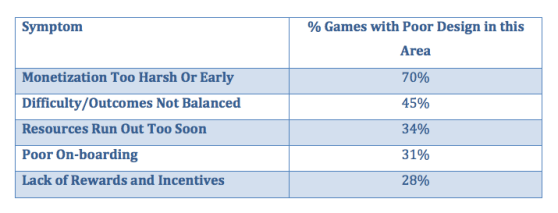This sponsored post is produced by Mark Robinson,CEO, deltaDNA.
How many poorly designed or frustratingly greedy free-to-play games are you playing at the moment? None, I’m guessing – which puts you firmly in the majority. Indeed, our research shows that poor game design causes up to 60 percent to 80 percent of players to leave a game for good following a disappointing first session.
The reality is harsh. If players don’t become engaged then they simply won’t spend. And if you don’t know why your players are leaving your game then it’s impossible to build long-term relationships. However, despite this, the number of free-to-play games that have poor game design elements that directly impact retention is shocking.
At deltaDNA, we assessed the design of over 80 games — complex massively multiplayer online worlds, through to casual Facebook and Social Casino games as well as some of the best performing mobile F2P titles. Their design effectiveness was scored against over 50 criteria in order to identify why players leave games before they have the potential to become engaged and loyal players.
Why players leave your F2P game will be discussed at the GamesBeat webinar on April 29th, click here to register. The top five reasons and levels of the percentages are startling:

The first 60 seconds of gameplay is incredibly important — players need to get in, enjoy themselves, and receive an immediate reward. But in the games we analyzed, poor onboarding was evident in 31 percent of games.
The start of the game should give as much of a taste of what it has to offer at the outset as possible. Give them an idea of what the best weapon, creature, or vehicle can do. If the best weapon in the game is the BFG, do you really want to wait until 90 percent of players have abandoned before making it available?
Another surefire way to lose players in the first session is to make the monetization mechanics either too harsh or too early, yet 70 percent of the games we analyzed suffer from this problem. Again, players that don’t become engaged won’t spend, so waiting until they reach the threshold of engagement is vital before introducing any monetization mechanics.
One of the common problems we found is games often lack player resources. In fact, 34 percent of the games we looked at failed to offer enough of one or more resources, resulting in players running out too soon in the game, which causes frustration. While the top guys might well be able to get by on the limited-resources available, it’s a mistake to think all players are the same. By thinking about the player experience very clearly and taking into account different levels of competency, patience, momentum, and competitiveness, it is possible to improve engagement.
The transition from selling boxed products to managing live gaming services has an inevitable learning curve for the majority of publishers and developers. Good F2P game design is a constant and difficult balancing act between retention and monetization. A data-driven approach supports engagement and helps build long-term player relationships, which with the cost of acquisition continuing to rise it’s an approach which publishers and developers will find increasingly difficult to ignore.
Learn more about Why Players Leave Your Game in our webinar April 29.
Sponsored posts are content that has been produced by a company that is either paying for the post or has a business relationship with VentureBeat, and they’re always clearly marked. The content of news stories produced by our editorial team is never influenced by advertisers or sponsors in any way. For more information, contact sales@venturebeat.com

